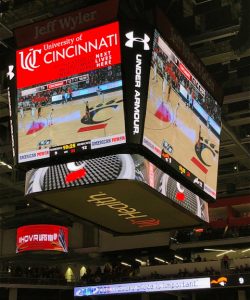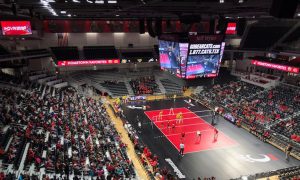University of Cincinnati, Daktronics Craft New Centerhung for Revamped Fifth Third Arena
Shared infrastructure, generous donors made the transformation possible
Story Highlights
The University of Cincinnati’s Fifth Third Arena, home to the Bearcats’ basketball and volleyball teams, went through a massive overhaul in March 2017 with extensive changes to seating, amenities, and overall look. The biggest change was installation of Daktronics videoboards, including a centerhung system that reaches from one three-point line to the other.
“It’s great to see the fans’ reaction,” says Megan Coffey, associate director, creative services and multimedia, University of Cincinnati, “hearing them say, ‘Wow, we had no idea videos could look that good.’”
The Video Upgrades
So that construction could proceed without distractions, the men’s basketball team played the 2017-18 campaign at BB&T Arena on the campus of Northern Kentucky University. The women’s basketball and volleyball teams played at nearby St. Ursula Academy. When all three teams returned home, they were greeted by an $87 million renovation. As with the $86 million undertaking at Nippert Stadium in 2012-14, the university received monetary funding from outside donors to enhance the 15-year-old videoboard in Fifth Third.

The new centerhung videoboard at Fifth Third Arena comprises nine separate elements, 3.9 million LEDs, and close to 2,000 sq. ft. of display area.
“[Administration] said, ‘Look, you can’t redo this brand-new, beautiful, state-of-the-art arena and have old videoboards,’” says Coffey. “They were able to get investors to invest in Daktronics [LED displays].”
Part of a wide array of advances, 36 new video displays were placed throughout the arena. The rectangular centerhung is cut into nine separate elements: two facing the sidelines (16 x 27 ft.), two facing the ends of the arena (16 x 16 ft.), four curves between the main slabs (16 x 6 ft.), and a ring beneath (3 ft. high x 86 ft. in circumference). On the court, ribbon boards outline the seating area and two mounted stanchion displays along the sides of the baskets. Four 9.5- x 28-ft. ring LED boards in each corner supply additional stats.
With more than 7 million LEDs and 5,700 sq. ft. of coverage, the centerhung alone accounts for 3.9 million LEDs and close to 2,000 sq. ft. The arena’s interior architecture emphasizes constant viewability of the LED behemoth: fans can view the scoreboard throughout the venue, with the help of two 360-degree concourses.
Adapting to New Possibilities
To ensure resolution quality and size for each display, video settings needed to be adjusted to fit the space’s specific requirements. For example, the centerhung has different dimensions for each panel.
“Because of sponsorship, we have our videoboard settings at a 16:9 ratio [for] live video and content within the game,” Coffey explains. “When [the production goes] full board, we need to make videos specifically for a 720×720 setting and a 1,248×720 setting as well.”
In addition, the production team needed to rethink filming strategy and execution prior to game time.
“We had to adjust not only how we film but even the settings on our camera [to 1,920×1,280],” says Coffey. “We’re not going to have to scale anything up or distort anything. Close-up stuff is going to look super–close-up now.”
A Combined Effort Puts the Show on the Air
Productions in Fifth Third Arena rely heavily on the full-scale control room at Nipper Stadium next door. In a fibered network and a shared infrastructure in terms of equipment, the neighboring venues work hand-in-hand.

The arena’s interior architecture enables the centerhung videoboard and other displays to be seen throughout the space.
“Everything is controlled, outside of the Daktronics system, out of Nippert,” says Coffey. “[Associate Athletic Director, Facilities and Technology,] Bill Frigge spent a lot of time getting fiber run from Fifth Third to the Nippert control room. We also share three cameras with Nippert.”
On the daily workflow, Coffey depends on student workers to facilitate tasks during hectic times. “We have 10-12 student interns that we rely on heavily to assist us with coverage,” she says. “This year, one of our academic leaders put a job listing within the Sports Management [degree program].”
Evolution Into a Multi-Purpose Space
Since joining UC in August 2014, Coffey has seen the university’s program mature and improve. To top off the alterations that will wow fans in the stands, Fifth Third Arena houses a fully furnished classroom for teaching the next wave of broadcast professionals.
“On game day, they use it as a club for upper-level donors,” she says. “During the week, it’s going to be a high-tech classroom with full video ability and programs, so teachers can do everything there.”
Recently, the women’s volleyball team watched their draw in the national tournament with the NCAA Selection Show shown on the videoboard. Also, the live production shown on the videoboard has been integrated into the team website’s live-stream workflow.
“For women’s basketball and volleyball,” says Coffey, “we plug an input into our live-stream production, and it pulls the full feed from the arena. Camera operators are now working for both ends.”
As the project heads into 2019, the program is using the technology as a stepping stone to a higher tier of production and content. “We’re trying to get to the same level as other schools,” Coffey says. “It’s great to see us coming together to put a good product out there, because our teams, athletes, and fans deserve it.”
